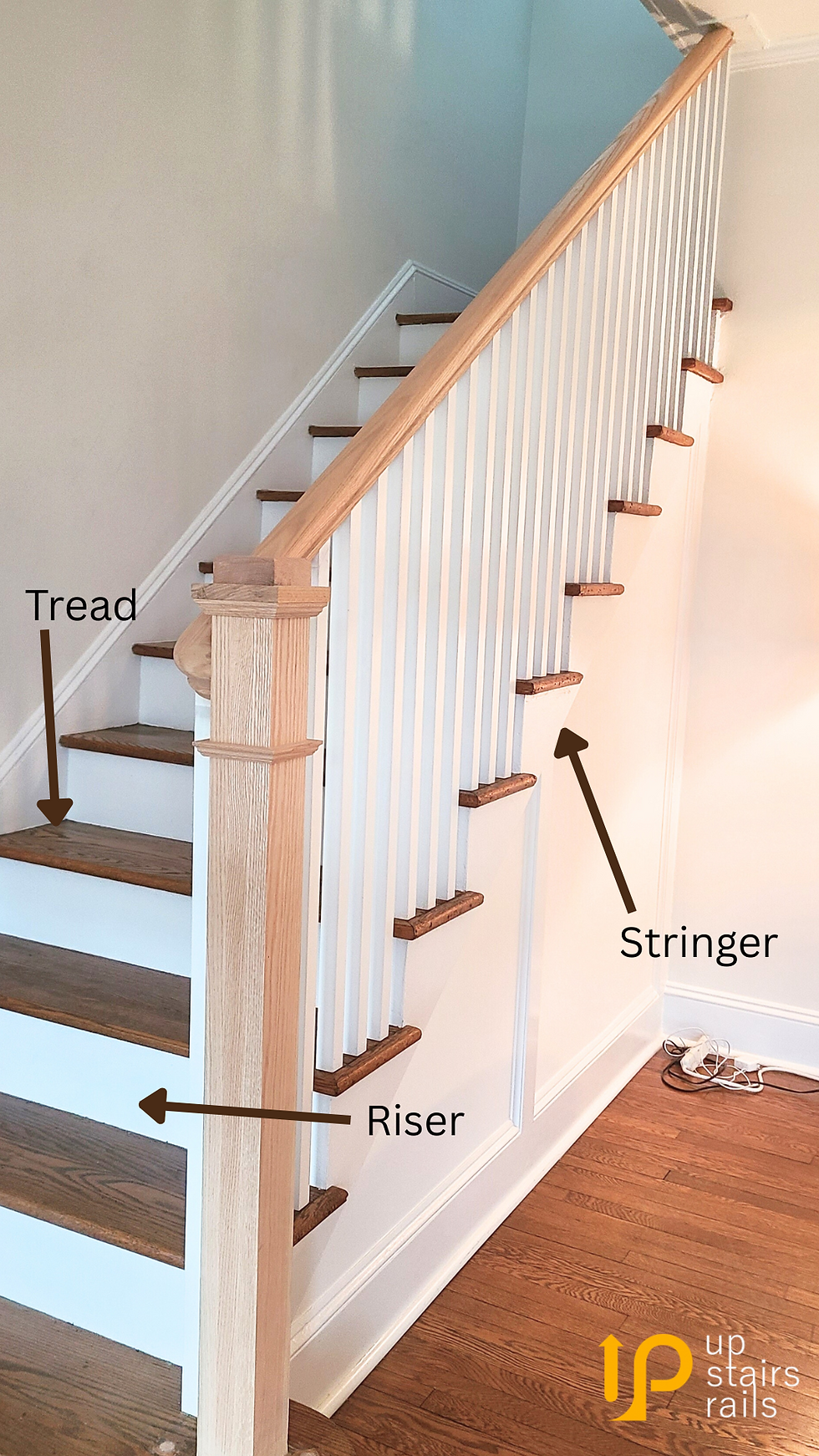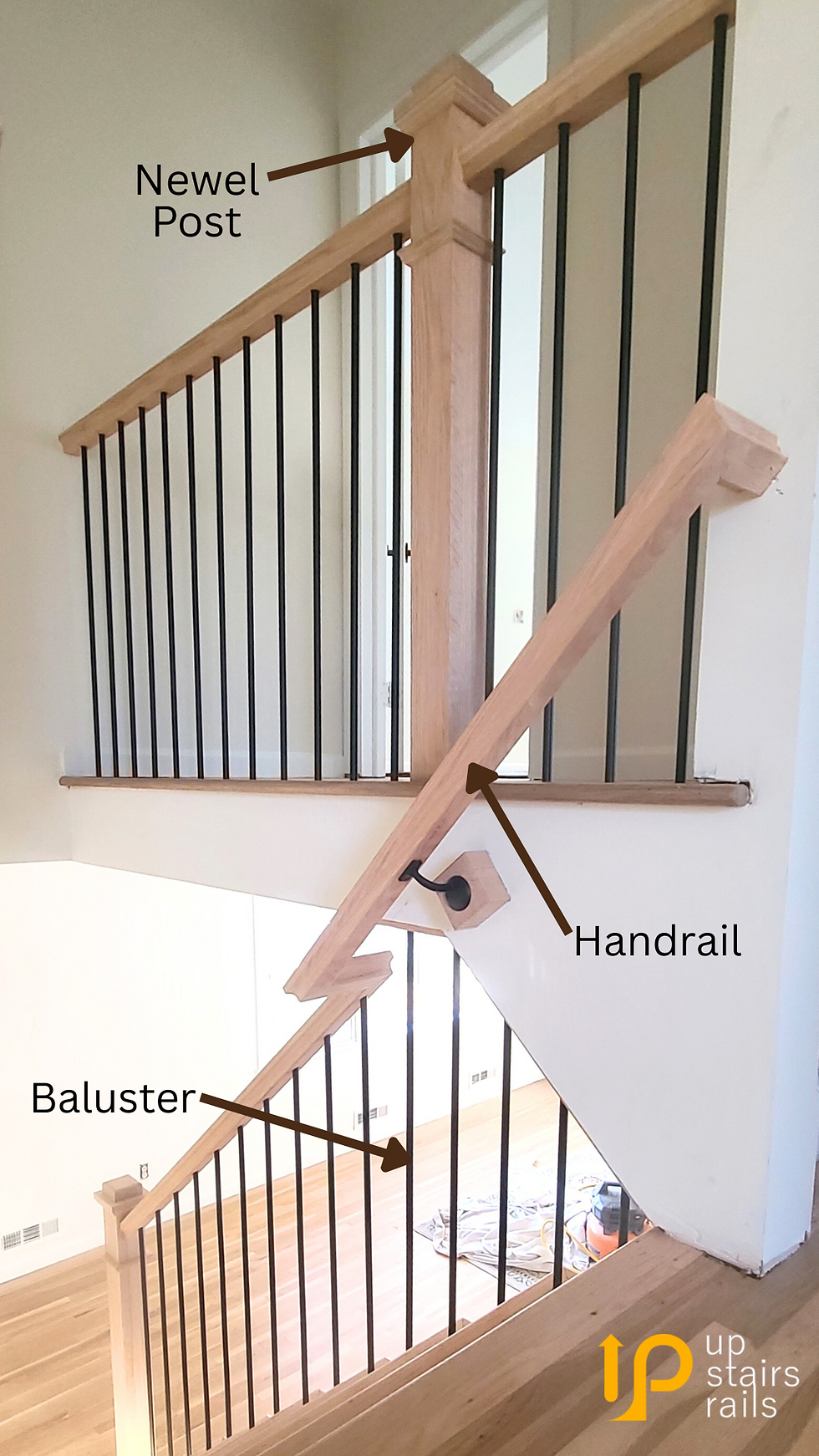Your Guide to Staircase Anatomy: Common Terms for Stairs & Railings
- Up Stairs Rails
- Apr 1
- 7 min read

Ever heard a contractor say, “We’re replacing your stringer,” and thought… my what? You’re not alone. Staircase terms can sound like a secret language if you’re not in the industry—and let’s be real, most homeowners aren’t casually tossing around words like baluster or newel post at brunch.
This blog breaks down the basic parts of a staircase and stair railing system in plain, no-nonsense language. Whether you’re prepping for a stair remodel or just trying to make sense of what your installer is saying, this guide will help you feel like you actually get what’s going on.
We’ll walk you through everything from risers and treads to the not-so-mysterious stringer—plus a few railing components that can completely change your home's style and safety. So if terms like stair railing parts, stair terminology, or parts of a staircase have ever left you scratching your head, you’re in the right place.

What Are the Main Parts of a Staircase?
Before diving into finishes, railing upgrades, or whether you want wood or metal, it's worth understanding the actual anatomy of a staircase. Trust us—knowing the difference between a riser and a stringer can make conversations with your contractor way easier (and help you avoid that blank stare when someone mentions "nosing").
Here are the essential stair components every homeowner should know:

Tread
This is the flat, horizontal part you step on as you go up or down the stairs.
It carries all the action—foot traffic, furniture hauls, the occasional flying toddler—and comes in a variety of materials.
Popular tread materials include:
Solid wood (red oak, white oak, pine)
Engineered wood
Metal (in more industrial or modern staircases)
Composite materials (less common indoors)
When someone says “we’re refinishing your treads,” this is the part they’re talking about.
Want to give your stairs a fresh new look without a full remodel? Upgrading your treads and risers can be a smart, cost-effective fix.
Riser
The riser is the vertical space between each tread. In other words, it’s the part that lifts your foot to the next step. Risers can be either:
Closed risers (solid, enclosed look)
Open risers (no vertical panel—creates a modern, airy vibe)
Open risers are stylish, but check your local building codes—some states have regulations based on spacing, especially if you have little kids or pets.
Stringer
The stringer is the backbone of your staircase. It’s the sloped support that runs along the side and holds everything (treads and risers) in place.
There are two main types:
Closed (solid) stringer – You don’t see the edge of the treads from the side.
Open (cut) stringer – The stair profile is visible, often more decorative.
Most indoor staircases have two side stringers, but some also have a middle stringer for added support.
Nosing
Nope, it’s not a typo. Nosing is the edge of the tread that slightly hangs over the riser below it. It helps provide a smoother transition when walking and adds an extra layer of grip for safety.
In design terms, nosing can be:
Rounded (bullnose)
Square
Decorative (for a more traditional look)
And if your stairs squeak? Sometimes the nosing’s to blame.

What Makes Up a Stair Railing System?
The railing system is where style meets safety. It’s not just there to keep you from tumbling down the stairs (though yeah—pretty important). It also plays a huge role in your home’s overall aesthetic. Whether you’re going sleek and modern or timeless and traditional, these are the indoor railing components that make it all come together:

Handrail
The handrail is the part you actually hold onto—your go-to grip for balance, safety, and stability.
It can be:
Mounted on the wall (wall rail)
Supported by balusters as part of a full railing system
Handrails come in a variety of profiles—rounded, square, or modern flat designs—and the finish or stain can totally shift the vibe of your space. Plus, code requires them in most cases, so they’re not optional.
Baluster (or Spindle)
Balusters are the vertical posts that run underneath the handrail. You’ve probably seen them in wood, metal, or even glass depending on the home style.
They:
Add style (think modern black metal vs. traditional white-painted wood)
Provide safety (especially for kids and pets)
Support the handrail structurally
Bonus tip: Replacing outdated balusters with modern metal ones is a super popular (and cost-effective) way to refresh your staircase without a full demo.
Curious about combining different materials for a more custom look? Mixing wood and metal railings is a great way to modernize your staircase without overhauling the whole thing.
Newel Post
Meet the anchor of the whole railing system—the newel post. It’s that thicker, often more decorative post you’ll find at the beginning, end, or any turning point of a staircase.
It does the heavy lifting, literally, by securing the entire railing structure.
Newel posts come in:
Boxy modern shapes
Turned or fluted styles for classic or traditional looks
Stained or painted finishes to match your home’s color palette
If you’re going for impact, updating the newel post alone can seriously upgrade your stair style.
Rail Bracket & Hardware
Behind every beautiful stair railing system is a bunch of not-so-glamorous—but crucial—hardware.
This includes:
Rail brackets (used to mount wall rails or connect sections)
Screws and fasteners (designed for structural integrity)
Mounting plates or bases (especially in metal systems)
They may be hidden behind wood trim or tucked underneath, but they’re what hold the whole setup together.

Common Stair & Railing Terms Homeowners Should Know
Not sure what a volute is? Wondering if a “gooseneck” involves actual birds? You’re not alone. Here’s a quick glossary of stair and railing terms that’ll help you talk the talk—and understand what’s going on during your next railing or staircase upgrade.
These are some of the most common stair terms you'll hear from installers, designers, or building code guidelines:
Landing The flat platform between flights of stairs. Used in turns or breaks, especially on longer staircases. Also helps meet code for safety and accessibility.
Volute A spiral or curled end of a handrail—typically found in traditional or decorative designs. It’s usually placed at the bottom of a staircase and adds a touch of flair.
Winder A wedge-shaped step used to turn a staircase without needing a landing. Found in tight spaces or curved staircases.
Return The part of the handrail or tread that turns back toward the wall or post. A handrail return brings the rail back to the wall for code compliance and a cleaner finish.
Cap Rail A decorative top rail that sits over a paneled or solid section of the railing (often seen in traditional designs). It’s what your hand rests on if there’s no gap with balusters.
Gooseneck A vertical curve in the handrail used to connect different levels—like when a railing has to rise up to meet a higher newel post on a landing.
Wall Rail A handrail mounted directly onto the wall (not part of a baluster system). Typically required in narrow staircases or along basement stairs for added safety.
These definitions aren’t just for show—they’re super useful when picking materials, planning layouts, or just understanding what your railing installer is talking about.

Why Knowing These Staircase Anatomy Terms Matters During Your Remodel
You don’t need to become a stair expert overnight—but having a basic grip on stair terminology gives you a serious leg up during a remodel. Knowing the difference between a tread and a riser, or a newel and a baluster? That’s power.
Whether you’re doing a full staircase renovation or just upgrading your stair railing design, here’s why these terms actually matter:
Communicate Stair Terminology Clearly with Your Contractor
Let’s be honest—nothing feels worse than nodding through a conversation when you’re secretly Googling half the words someone just said.
Understanding key stair railing parts means you can:
Ask better questions
Catch red flags early
Be part of the conversation, not just a passive listener
You’ll also be way more confident when reviewing your quote and final design plans.
Make Smarter Stair Railing Design Decisions
Trying to choose between a modern floating staircase or a traditional box newel setup? Knowing your stair components helps you visualize what’s being described and communicate what you actually want.
Whether you’re:
Mixing wood and metal
Picking a new handrail profile
Choosing between open or closed risers
...understanding the terminology = better design choices.
Understand Stair Railing Parts to Plan Your Budget
The more you know about your indoor railing components, the easier it is to stay on budget. If your contractor throws in terms like “return,” “tread cap,” or “volute,” you’ll know what you’re paying for—and what’s just fluff.
Knowing the parts of a staircase helps you:
Read and compare quotes
Prioritize what’s essential
Avoid surprise costs mid-project

FAQ: Answering Common Stair & Railing Questions
What is the railing on stairs called?
It’s called a handrail. Depending on the setup, it can be mounted on the wall (a wall rail) or supported by balusters as part of a full stair railing system.
What’s the difference between a baluster and a newel post?
A baluster is one of the smaller vertical posts that sit between the handrail and the stairs. A newel post is the larger, sturdier vertical post found at the beginning, end, or turns of the staircase. It anchors the whole railing system.
Do all stairs need a handrail?
In most cases, yes—especially if your stairs have more than three steps. Local building codes typically require handrails for safety. Always check with a licensed pro to make sure your staircase meets code.
What are the vertical and horizontal parts of stairs called?
The vertical part is called the riser, and the horizontal part you step on is the tread. Together, they make up each step of the staircase.
How do I know if my staircase is up to code?
You’ll need to check your local building codes, which can vary by state or even municipality. A professional railing installer can help you evaluate your current setup and let you know if any updates are needed for safety or compliance.

Build Your Knowledge Before You Build Your Staircase
Knowing the basics of stair and railing terminology isn’t just about sounding savvy at your next contractor meeting (though, hey, that’s a perk). It’s about making smarter decisions, planning with confidence, and feeling like you’re actually in control of your own remodel.
Whether you’re upgrading your stair railing, refinishing treads, or going for a full staircase overhaul, understanding the language makes everything easier—and way less stressful.
Not sure where to start with your next project? These must-do steps before installing a new railing will help you plan ahead and avoid common pitfalls.
Ready to upgrade your railing or remodel your stairs? We’re here to help make it smooth, safe, and stylish every step of the way.
With years of experience and a focus on quality, Up Stairs Rails is here to help you upgrade your indoor stairs and railings. Reach out anytime for a free estimate.


Comments